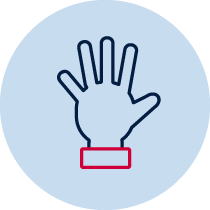Multiplication and division – cats on a mat
Students model and use equal groups of objects as a strategy for multiplication.
 |
 |
 |
 |
 |
| Practical | Build and make | Resource required | Teacher observation | Individual |
Number – multiplication and division
- uses a range of mental strategies and concrete materials for multiplication and division MA1-6NA
- describes mathematical situations and methods using everyday and some mathematical language, actions, materials, diagrams and symbols MA1-1WM
Syllabus content descriptors
Model and use equal groups of objects as a strategy for multiplication
- model and describe collections of objects as 'groups of', e.g. the image shows 2 circles with 3 dots in each, ‘2 groups of 3’,
- recognise the importance of having groups of equal size (Reasoning)
- determine and distinguish between the 'number of groups' and the 'number in each group' when describing collections of objects (Communicating)Literacy
- find the total number of objects using skip counting
Materials
Students can be provided with more than 20 counters if required.
Teacher instructions
The purpose of this task is to gauge students’ understanding of multiplication and division concepts such as:
- model and describe collections of objects as 'groups of',
- recognise the importance of having groups of equal size
- determine and distinguish between the 'number of groups' and the 'number in each group' when describing collections of objects
- find the total number of objects using skip counting
Teachers read the question to the student and observe the student's response, looking for the strategy that the student is using.
Investigate how students have solved the problem: Have students for example:
- used the concrete materials (counters), to make equal groups of four by dealing each item by ones.
- used the concrete materials (counters) in groups in perceptual counting and sharing (rhythmic or skip counting with all items visible)
- relied on perceptual markers of each cat to represent each group of four. The student counts without individual items visible but needs to represent the groups before determining the total. The student may count by twos.
- used composite units in repeated addition and subtraction using the unit a specified number of times. They may use skip counting and may use fingers to keep track of the number of groups as the counting occurs. The student determines the total or number of equal groups where the individual items cannot be seen.
- coordinated two composite units (mentally) as an operation (that is, both the number of groups and the number in each group are treated as composite units)
- used known single-digit multiplication facts (5 cats with 4 legs each is 20 legs altogether because 5 x 4 = 20). The student applies known facts and strategies for multiplication to mentally calculate (four 4’s is 16 plus 1 more group of 4 or 5 x 4 is half of 10 x 4). The student uses commutative properties of numbers (5 x 4 is the same as 4 x 5 = 20)
Student instructions
Show the diagram of the 5 cats to the student. Read the question to the student. There are 5 cats sitting on a mat, how many legs altogether?
Possible areas for further exploration
Do students recognise that cats have 4 legs?
Where to next?
Model the commutative property of multiplication, e.g. '3 groups of 2 is the same as 2 groups of 3'
Solve multiplication and division problems using objects, diagrams, imagery and actions
- support answers by demonstrating how an answer was obtained (Communicating)
- recognise which strategy worked and which did not work and explain why (Communicating, Reasoning)
Record answers to multiplication and division problems using drawings, words and numerals, for example, 'two rows of five make ten', '2 rows of 5 is 10'.
Please note:
Syllabus outcomes and content descriptors from Mathematics K-10 Syllabus © NSW Education Standards Authority (NESA) for and on behalf of the Crown in right of the State of New South Wales, 2012